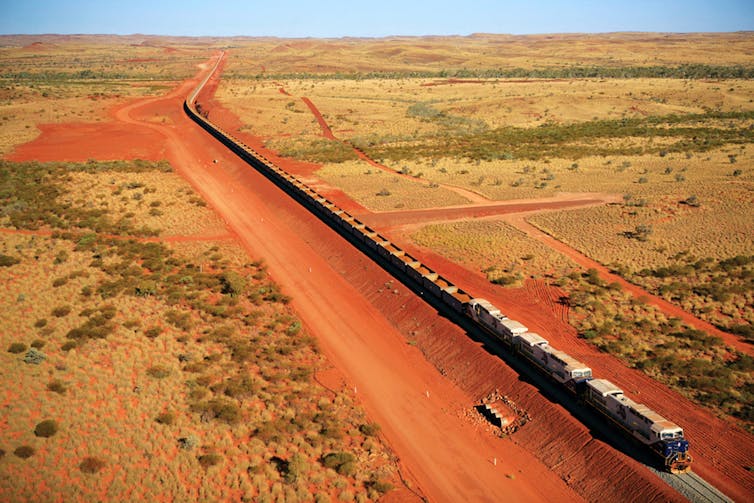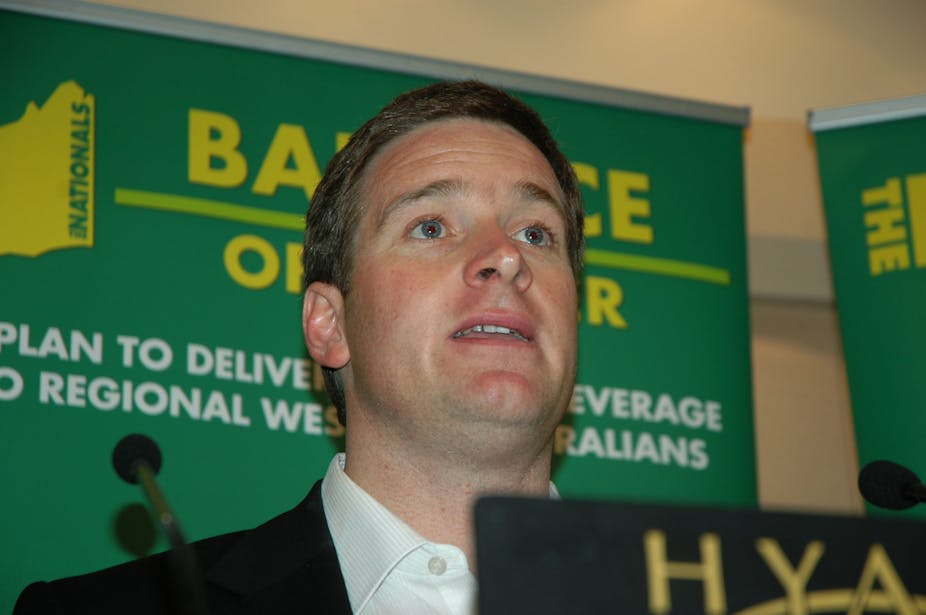Arguably the most intriguing electoral contest in the Western Australian state election on March 9 is the Pilbara. The leader of the Western Australian Nationals, Brendon Grylls – architect of the multi-billion dollar Royalties for Regions program and political king-maker in the 2008 election – has vacated his ultra-safe electorate of Central Wheatbelt to run for a seat that Labor holds with a more than handy 7.2% margin. Why?
This apparently risky move is the latest step in a political strategy adopted by Grylls since 2005. And whichever way it turns out, it could have wider significance than the fate of just one candidate and one seat.
Resurgence and political strategy
The Nationals’ future looked bleak in Western Australia when one-vote, one-value legislation was finally passed in 2005. Several rural seats disappeared, and the Nationals were widely predicted to be heading for permanent marginalisation. Instead, the Nationals adopted a three-pronged political strategy: greater independence from the Liberal Party; a move to become a truly regional party; and Royalties for Regions.
Despite being coalition partners with the Liberals in Richard Court’s government, the Nationals have always had an independent streak, splitting in two in the 1970s over the issue of the closeness of their relationship with the Liberals and refusing to join in formal coalition following the election defeat in 2001.
Grylls argued consistently in the lead-up to the 2008 election that his automatic support for the Liberal Party could not be guaranteed. When the election resulted in the Nationals holding the balance of power, Grylls and his younger colleagues were reportedly keen to side with Labor in the post-election negotiations, until the party’s traditional rural wing brought him back into line to support a governing alliance with Colin Barnett’s Liberals. This was only once the unconditional condition for support of Royalties for Regions had been met.
The Nationals’ independent streak continued in 2010 when their candidate for the federal seat of O’Connor, Tony Crook, defeated longstanding Liberal MP Wilson Tuckey, and refused to join the federal Nationals’ party room in Canberra.
The second strand of the Nationals’ strategy has been to broaden their electoral base. In 2008, they contested all five seats in Western Australia’s mining and pastoral region. Although they failed to win any, the Nationals won more than 20% of the primary vote and returned a member in the Legislative Council from this region for the first time.
Since then the politics has grown even more promising for the Nationals in these seats. First the independent member for Kalgoorlie, former Labor Minister John Bowler, who had resigned from Labor in 2007, announced immediately after the 2008 election that he would support the Nationals’ position in their negotiations between Labor and the Liberals. He is retiring at the 2013 election and has endorsed the Nationals’ candidate.
Then in 2009 the Labor member for North West, Vince Catania, quit Labor and joined the Nationals and is now seeking re-election. In the coming election, the sitting Labor members in the seats of Kimberley and Pilbara are retiring, and the Nationals see an opportunity to win one or both. It is conceivable that the Nationals could soon hold three or even four of the five mining and pastoral seats, from a position where they didn’t even contest them in 2005.
Pilbara boom
The policy context to this political strategy is the state government’s “Royalties for Regions” program, devised by the Nationals in opposition and delivered in the aftermath of the 2008 state election. A quarter of the state’s mining royalties are quarantined for additional spending in the regions, with Grylls, in his position as Minister for Regional Development and Lands, in charge of the program. So far, more than $1 billion a year has been spent.

Significant expenditure has been directed across regional Western Australia, to industrial infrastructure, town development, hospitals, schools, roads, as well as general amenities such as swimming pools and recreation centres. The Pilbara – the economic powerhouse of the nation with billions of dollars of private investment and exports in iron ore and natural gas – has been particularly targeted. The Pilbara Cities program aims to develop Karratha and Port Hedland into cities of 50,000 people by 2035, as a way of rebuilding communities and moving away from a reliance on fly-in fly-out workers.
Already the population of the four Pilbara shire councils has grown from 39,000 in 2001 to 63,000 people in 2011 – and this does not include the massive increase in FIFO workers. The Pilbara has the fastest growing population in regional Australia. Average weekly incomes are very high, as is employment. But the flipside is incredibly high rents and house prices, which put a major burden on people and businesses not involved in the resources sector, along with environmental pressures and longstanding indigenous disadvantage.
Grylls’ move to contest the Pilbara will be a test of whether the community wishes to reward him and his party for the efforts made so far to invest in these communities, or whether they will see him as a “fly in fly out” politician, as charged by his Labor opponent.
What are his chances? Despite Labor’s 7% margin based on 2008 results, some factors are likely to work in Grylls’ favour, in addition to the political benefits from Royalties for Regions. The long-term Labor MP, Tom Stephens, is retiring. His replacement is the Mayor of Port Hedland, Kelly Howlett, but the greatest population growth has been in Karratha and Newman, where Labor had a lower share of the vote in 2008. The big influx of new residents may be less “rusted on” Labor supporters than those of longer standing. One unknown is the turnout as only 69% of enrolled electors voted in 2008. If either side can get its supporters to the polls in greater numbers, they may have the edge.
There may also be broader implications to the battle for Pilbara – beyond the obvious one of the Western Australian Nationals needing a new leader if Grylls loses.
The election
The future of the Nationals has been an ongoing question in Australian politics for years, with a number of strategic options being considered. One – amalgamation with the Liberal Party – has been adopted in Queensland and Northern Territory. A second – the status quo of the Nationals remaining the junior partner in coalition with the Liberals – has held sway federally and in New South Wales and Victoria. The third option – a more independent stance – has been the choice in Western Australia and, to some extent in South Australia where Labor governed for a period with Nationals’ support.
If Grylls’ party can move out of its rural heartland to become a truly regional party with a more independent streak, then they may have the basis for a tilt at a Western Australian Senate seat and possibly to challenge the Liberals in the federal seat of Durack. Conceivably such a strategy, backed up by a Royalties for Regions-style program, could also be attractive in New South Wales and federally.
For Labor, the irony is that its long-held dream of one-vote one-value may see it lose some or all of its remaining seats in regional Western Australia and risk being branded a purely metropolitan party. Avoiding that fate will be a major challenge over the next four weeks, beginning in the Pilbara.

